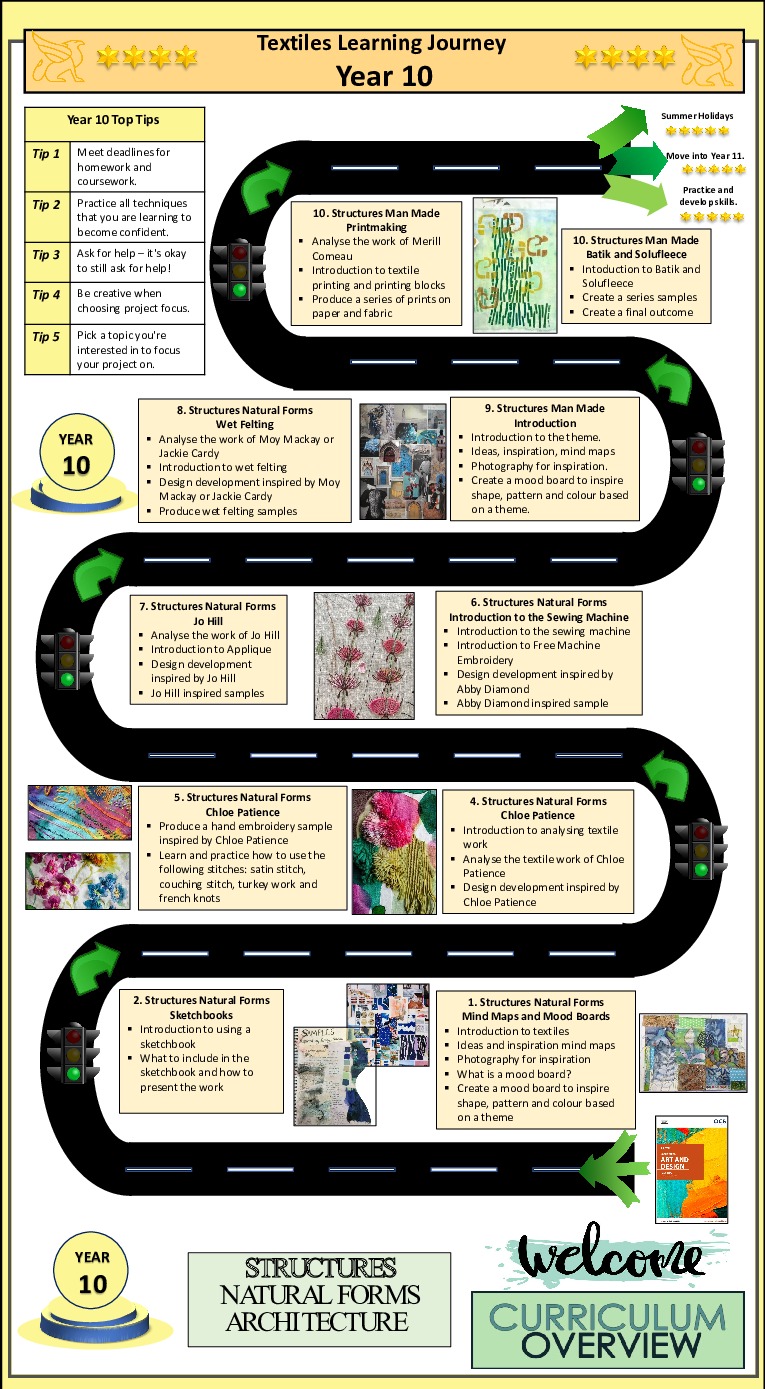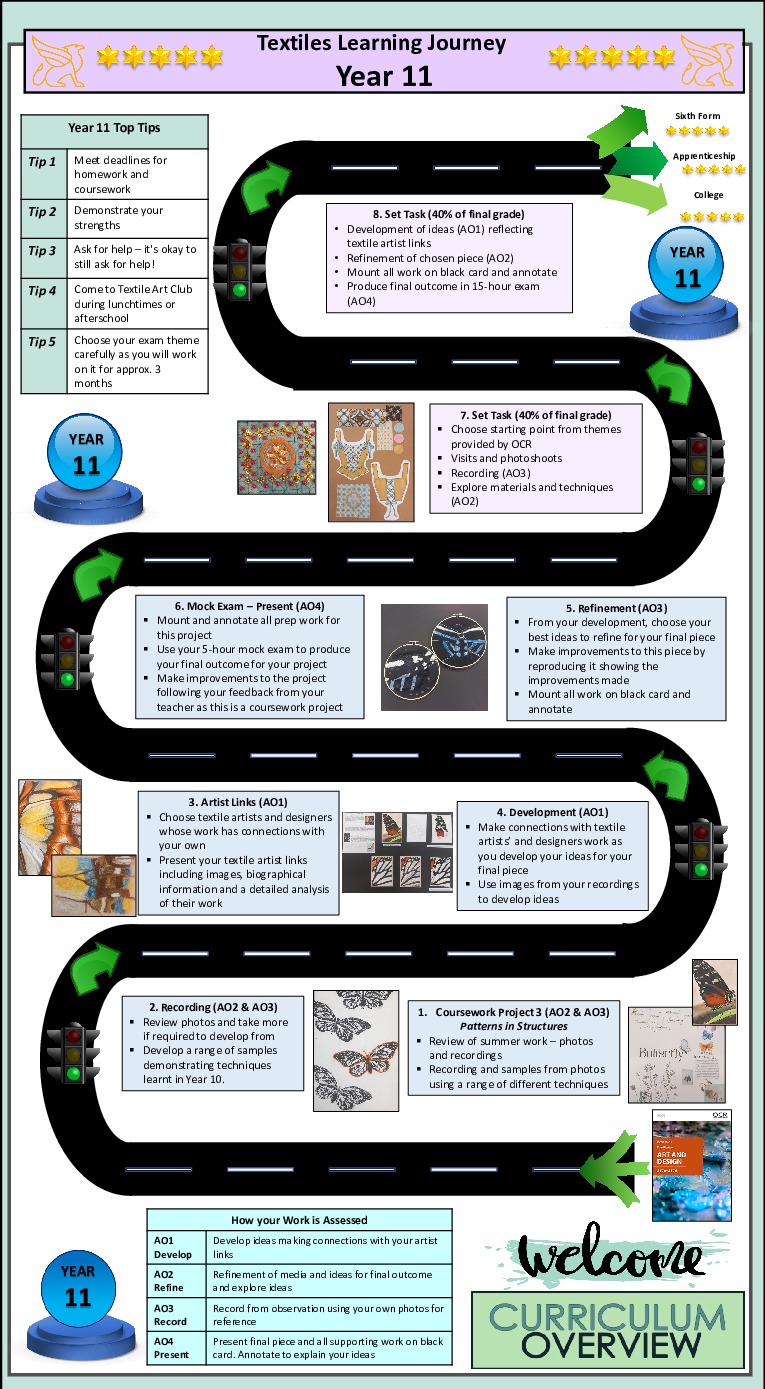Textiles
BackTextiles is the application of creative ideas through a range of different textile skills and techniques: it teaches you how to observe and construct what you have observed through a range of different textile media. Textiles is about being inspired by others and reflecting on their work to influence your own.
Learning Journey


Curriculum Overview
| Year 7 | Textiles Project |
|---|---|
| Key Topic: | Monster Mash – Sock Monster |
| New Knowledge |
Introduction textiles and to creating 3D textile sculptures responding to the textile artist John Murphy. Create a fabric phone or pencil case inspired by Jon Burgerman that focuses on different decorative techniques and exploring various textile techniques. |
| Previous Knowledge Required: | None |
| New Skills: |
Understand and analyse the work of John Murphy and Jon Burgerman and their purpose, techniques and subject matter. Design development from observational drawings from moshi monsters and monster images; looking at shape, form, pattern, colour, line and proportion. Experiment with a range of different materials, exploring different textile techniques. Understand the different elements of a sewing kit. Understand how to complete basic stitches (running and whip). Explore different techniques to apply colour and pattern. To experiment with stitch for construction and decoration. Develop the ability to make decisions and work through refining and modifying ideas/ processes independently to create personal and meaningful responses that realise students’ intentions. |
| Links to the School Curriculum: |
Art Design and Technology |
| Independent Activities: |
Independent development of the project theme showing individual creative ideas from concept to completion. Strong connections with the work of practitioners to support independent ideas and the improvement of their skills. |
| Web Links: | https://www.amazon.co.uk/Stupid-Sock-Creatures-Lovable-Cast-off/dp/1579906109https://jonburgerman.com/ |
| Year 8 | Pillow Project |
|---|---|
| Key Topic: | Pillow Packet |
| New Knowledge |
Students will understand the process to create a packet shaped cushion. Students will analyse the work of textile artists such as Holly Levell and Claes Oldenburg. |
| Previous Knowledge Required: |
Understand and analyse the work of textile artists and their purpose, techniques and subject matter. Design development from observational drawings. Looking at shape, form, pattern, colour, line and proportion. Experiment with a range of different materials, exploring different textile techniques. Understand the different elements of a sewing kit. Understand how to complete basic stitches. Explore different techniques to apply colour and pattern. To experiment with stitch for construction and decoration. Develop the ability to make decisions and work through refining and modifying ideas/ processes independently to create personal and meaningful responses that realise students’ intentions. |
| New Skills: |
Understand and develop the technique of Applique. Introduction to the sewing machine. |
| Links to the School Curriculum: |
Art Food Technology Graphics |
| Independent Activities: |
Independent development of the project theme showing individual creative ideas from concept to completion. Strong connections with the work of practitioners to support independent ideas and the improvement of their skills. |
| Web Links: | https://www.youtube.com/watch?v=eB91flTprsI |
| Year 9 | Pop Bag Project |
|---|---|
| Key Topic: | Pop Bag - Bag Design |
| New Knowledge |
Students will create a bag design inspired by the work of textile designer Edo Morales and Sarah Gwyer. Students will research what the term ‘Pop Culture’ is and how it effects the design industry. Students will analyse the work of artists and art movements such as Pop Art. |
| Previous Knowledge Required: |
Understand and analyse the work of textile artists and their purpose, techniques and subject matter. Design development from observational drawings. Looking at shape, form, pattern, colour, line and proportion. Experiment with a range of different materials, exploring different textile techniques. Understand the different elements of a sewing kit. Understand how to complete hand embroidery stitches. Understand how to complete Applique. Explore different techniques to apply colour and pattern. To experiment with stitch for decoration. Develop the ability to make decisions and work through refining and modifying ideas/ processes independently to create personal and meaningful responses that realise students’ intentions. |
| New Skills: |
How to embellish designs using a range of different textile techniques. |
| Links to the School Curriculum: |
Art Media |
| Independent Activities: |
Independent development of the project theme showing individual creative ideas from concept to completion. Strong connections with the work of practitioners to support independent ideas and the improvement of their skills. |
| Web Links: | https://www.tate.org.uk/kids/explore/what-is/pop-art |
| Year 10 | Term 1 | Term 2 | Term 3 |
|---|---|---|---|
| Key Topic: | STRUCTURES: NATURAL FORMS | STRUCTURES: NATURAL FORMS | STRUCTURES: MAN MADE |
| New Knowledge: |
Understand and analyse the work of Yellena James and Moy Mackay. Their purpose, techniques and subject matter. |
Understand and analyse the work of Vanessa Barragao. The history of weaving and the Dovecot Studios. |
Understand and analyse the work of Rosie James and Carrie Ann Schumacher. |
| Previous Knowledge Required: |
Drawing from observation in a range of media; looking at patterns, texture, colour and line. |
Informed choices in the final stages of realising their intentions in final outcomes to produce a final textile artwork. |
Rigorous contextual research. Purposeful connections to textile artists. Making effective use of the work of others to inform their own practice. The use of annotations to explain journey and clarify connections. Experiment with a range of textile techniques such as: Hand embroidery Machine embroidery Develop the ability to make decisions and work through refining and modifying ideas/ processes independently. Drawing from observation in a range of media; looking at patterns, texture, colour and line. Photography used as a visual research tool to good effect to contribute not only to investigations and development but also to the growth of their understanding and use of visual language. |
| New Skills: |
Rigorous contextual research. Purposeful connections to textile artists. Making effective use of the work of others to inform their own practice.
The use of annotations to explain journey and clarify connections.
Experiment with a range of new materials, exploring different textile techniques such as: Hand embroidery Machine embroidery Printmaking Wet felting Needle felting Photography used as a visual research tool to good effect to contribute not only to investigations and development but also to the growth of their understanding and use of visual language. |
Develop the ability to make decisions and work through refining and modifying ideas/ processes independently. Experiment with a range of new materials, exploring different textile techniques such as: Weaving Embellishments |
Experiment with a range of new materials, exploring different textile techniques such as: Batik Using found materials for sample development.
Informed choices in the final stages of realising their intentions in final outcomes to produce a final recycled garment. |
| Links to the School Curriculum: |
Biology Photography |
Technology History |
Geography |
| Independent Activities: |
Independent development of the project theme showing individual creative ideas from concept to completion. Strong connections with the work of practitioners to support independent ideas and the improvement of their skills. Assembling relevant source material for personal themes. Visits to galleries, exhibitions and museums contributing to candidates work. Using the research gained to be informative in the development of independent projects. |
Independent development of the project theme showing individual creative ideas from concept to completion. Strong connections with the work of practitioners to support independent ideas and the improvement of their skills. Assembling relevant source material for personal themes. Visits to galleries, exhibitions and museums contributing to candidates work. Using the research gained to be informative in the development of independent projects. |
|
| Web Links: | https://yellena.comhttps://www.moymackaygallery.com | https://www.vanessabarragao.comhttps://dovecotstudios.com | https://www.textilecurator.com/home-default/home-2-2/rosie-james/www.carrieannschumacher.com |
| Year 11 | Term 1 | Term 2 | Term 3 |
|---|---|---|---|
| Key Topic: | STRUCTURES: UNDER THE MICROSCOPE | SET TASK | SET TASK |
| New Knowledge: |
Understand and analyse the work of independently selected textile artists. Their purpose, techniques and subject matter. |
Understand and analyse the work of independently selected textile artists. Their purpose, techniques and subject matter. |
Understand and analyse the work of independently selected textile artists. Their purpose, techniques and subject matter. |
| Previous Knowledge Required: |
Rigorous contextual research. Purposeful connections to textile artists. Making effective use of the work of others to inform their own practice. The use of annotations to explain journey and clarify connections. Experiment with a range of textile techniques such as: Hand embroidery Machine embroidery Printmaking Wet felting Needle felting Batik Repurposing recycled materials Develop the ability to make decisions and work through refining and modifying ideas/ processes independently. Drawing from observation in a range of media; looking at patterns, texture, colour and line. Photography used as a visual research tool to good effect to contribute not only to investigations and development but also to the growth of their understanding and use of visual language. |
Rigorous contextual research. Purposeful connections to textile artists. Making effective use of the work of others to inform their own practice. The use of annotations to explain journey and clarify connections. Experiment with a range of textile techniques such as: Hand embroidery Machine embroidery Printmaking Wet felting Needle felting Batik Repurposing recycled materials Develop the ability to make decisions and work through refining and modifying ideas/ processes independently. Drawing from observation in a range of media; looking at patterns, texture, colour and line. Photography used as a visual research tool to good effect to contribute not only to investigations and development but also to the growth of their understanding and use of visual language. |
|
| New Skills: |
|
Working under timed conditions to create a final outcome. |
|
| Links to the School Curriculum: |
Biology |
Subjects demand on chosen theme. |
|
| Independent Activities: |
Independent development of the project theme showing individual creative ideas from concept to completion. Strong connections with the work of practitioners to support independent ideas and the improvement of their skills. Assembling relevant source material for personal themes. Visits to galleries, exhibitions and museums contributing to candidates work. Using the research gained to be informative in the development of independent projects. |
|
|
| Web Links: | https://artthescience.com/bloghttps://www.klariart.comhttps://karolinreichardt.com | https://www.textileartist.org |

